On & Off the Hill
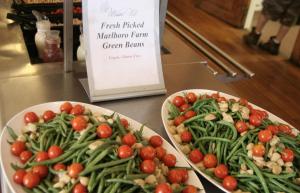 New faculty members, new greenhouse, new library books, oh my! Say farewell to storied sociology professor Jerry Levy and learn what environmental studies looks like in China.
New faculty members, new greenhouse, new library books, oh my! Say farewell to storied sociology professor Jerry Levy and learn what environmental studies looks like in China.
New greenhouse focuses interest in sustainability

Community members from campus and beyond gathered in October for the dedication of the new greenhouse on the Marlboro campus, located across the road from Persons Auditorium. The 700-square-foot, wood-and-glass structure is the culmination of three years of planning and community labor, and stands to be the focal point for students and faculty engaged in farming, renewable resources and other aspects of sustainable living.
“Some people who have contributed to the greenhouse are interested in agriculture, while others are involved with architecture or sustainable building, so there are a lot of different motivations,” said chemistry professor Todd Smith, who has been instrumental in keeping the project moving forward. “I certainly think a lot of people support the greenhouse, and farm, as a kind of demonstration of the college community’s interest in sustainability.”
 The greenhouse structure is made mostly of local or recycled materials, including local black locust and white oak timbers, pine siding and insulated glass recycled from Persons Auditorium. The design features a steep, glass roof facing south, a north wall built into the ground and a round entryway on the north side that doubles as a community meeting space.
The greenhouse structure is made mostly of local or recycled materials, including local black locust and white oak timbers, pine siding and insulated glass recycled from Persons Auditorium. The design features a steep, glass roof facing south, a north wall built into the ground and a round entryway on the north side that doubles as a community meeting space.
Students have long recognized the need for a greenhouse to connect the farm to the college, as a way to extend the growing season into the fall and spring when the college is in session. There have been two other greenhouses at this same site before, student-designed hoop houses that proved insufficient to survive the Vermont winters.
After students advocated for a sturdier structure, the design for this greenhouse was devised by student Kenton Card ’10, working with fellow students, staff and faculty, as part of his final Plan of Concentration. Kenny began milling local wood for the structure and collecting stones for the foundation and retaining walls that year, and the structure has steadily grown since then with the help of other community members.
“Kenny was interested in architecture, but also in how communities use spaces,” said Todd. “So he was very interested in how the greenhouse might serve to enhance activity at the farm and bring other community members down to the farm to get involved.”
“A lot of people don’t know where the farm is. I’ve run into this pretty frequently,” said sophomore Simeon Farwell-Miller, the current farm manager. “I think that visibility has been a problem in the past, but with the construction of the greenhouse the farm will be much more apparent. And we’re planning to plant flowers and medicinal herbs and other attractive things in front of the greenhouse, which should make it even more eye-catching.”
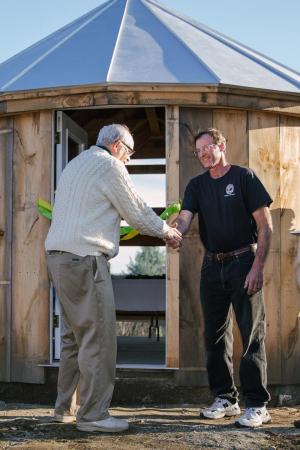 The greenhouse dedication comes at a time when awareness of local foods and other sustainable practices is growing on campus. The dining hall, under the dedicated guidance of general manager Richie Brown, is increasingly buying its raw ingredients from local or organic sources. The Environmental Quality Committee is stepping up efforts to recycle and compost, and the Food Committee is working with the community to eliminate the use of disposable cups. The farm, benefitting from its first summer with two fully paid managers, has supplied fresh food to both the coffee shop and the dining hall.
The greenhouse dedication comes at a time when awareness of local foods and other sustainable practices is growing on campus. The dining hall, under the dedicated guidance of general manager Richie Brown, is increasingly buying its raw ingredients from local or organic sources. The Environmental Quality Committee is stepping up efforts to recycle and compost, and the Food Committee is working with the community to eliminate the use of disposable cups. The farm, benefitting from its first summer with two fully paid managers, has supplied fresh food to both the coffee shop and the dining hall.
A key rationale for the greenhouse has been to draw more faculty and students to use the farm as a class resource for teaching or research. Todd Smith, for example, has based his General Chemistry Lab on the production of biofuels, growing sunflowers on the farm to collect the seeds, extract the oil and manufacture fuel. Other applications could range from growing experiments to farm poetry.
The official ribbon-cutting at the dedication was performed by Don Capponcelli, college carpenter, whose work was instrumental in the greenhouse’s completion and who has been a tireless advocate for the project. Present at the dedication were Bob Allen, president of the Windham Foundation, and neighbor David White, both of whom generously supported the greenhouse project. Other supporters, not able to be present, include Charles J. and Susan J. Snyder, Dr. Suzanne Olbricht and Jon A. Souder ’73. Kenny was enthusiastically present at the celebration via Skype from Germany, where he was attending a graduate program in architecture.
Marlboro takes environmental studies to China
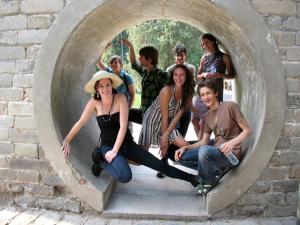 “It’s easy to forget how small the earth is when at Marlboro, where the air is clear and the trees are tall,” said writing professor Kyhl Lyndgaard. “Being in China made us aware of how pervasive human influence can be.”
“It’s easy to forget how small the earth is when at Marlboro, where the air is clear and the trees are tall,” said writing professor Kyhl Lyndgaard. “Being in China made us aware of how pervasive human influence can be.”
Kyhl was one of seven faculty and ten students who traveled to China for three weeks last summer to explore dimensions of environmental and social issues there. This was the last in a series of fruitful visits to Asia, including China, Japan, Vietnam and Cambodia, supported by two generous grants from the Freeman Foundation. The trip followed a seminar last spring called China’s Environmental Challenges, which laid the theoretical groundwork and practical background for the visit.
“The preparatory seminar helped us calibrate our expectations, but nothing prepared me for what we saw,” said economics professor Jim Tober, who has a special interest in environmental economics and policy. “One can read about rates of growth, construction booms, consumerism and so on, and still be totally taken aback by cities of 10 million, like Harbin, that seem to be materializing before our very eyes.”
Grant Li, professor of Chinese language, and Seth Harter, professor of Asian studies and history, were instrumental in making the trip rewarding through their logistical footwork and relevant knowledge. The group arrived in Beijing, a city of 20 million, and visited many of the nearby attractions, such as the Forbidden City, the Summer Palace and the Great Wall. But they also spent time meeting with local environmental agencies, activists and researchers, from the People’s University Legal Clinic for Pollution Victims to the Zhalong Crane Nature Reserve. At Heilongjiang University, in Harbin, they were joined by eight students of English, who acted as guides and translators and gave Marlboro students the opportunity to have home visits and other outings.
A highlight for Kyhl was the chance to reconnect with Chinese colleagues he had met when they were visiting scholars at University of Nevada, Reno. The reunion prompted a lively discussion at Beijing International Studies University, one of several opportunities for Marlboro students to talk about environmental issues on campuses in China.
Jim said, “There was much disagreement among students and faculty and others we met as to whether more substantive attention to environmental degradation would follow naturally from the production of wealth in China, such that the country could ‘afford’ improvements— after all, it was suggested to us, look at the same trajectory in U.S. history—or whether the rapidity and severity of decline called for a more aggressive response.” He found the Harbin Siberian Tiger Park a particularly fascinating insight into the public consumption of conservation and endangered species protection in China. Visitors to the park ride through caged areas to view tigers, ligers and lions, and feed them live animals for an extra price. “While the nominal purpose for the breeding program might be to reintroduce tigers into the wild, there has never been a reintroduction in China and it is not even clear that there is a reintroduction plan in place.”
“Environmental studies in China is even more complex because the systems at work are different than their American counterparts,” said junior Casey Chalbeck. “For me, to even begin to understand some of the environmental issues China is faced with required a strong and critical interdisciplinary approach that took me out of my intellectual comfort zone. Being able to study alongside such a diverse group of professors and students really facilitated this for me, and because of that I feel like a better student.”
Chinese partners host faculty
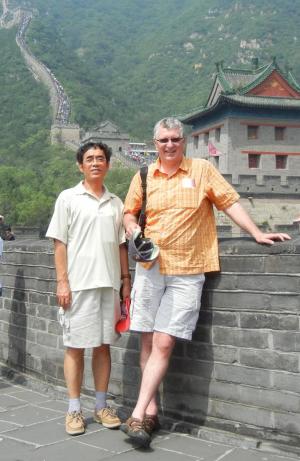 In July, Dean of Faculty Richard Glejzer joined Grant Li—who had stayed on at Heilongjiang University with three environmental studies trip students—and four more Marlboro students for a six-week language program (Potash Hill, Winter 2011). Together, the two Marlboro faculty members made great strides in establishing student exchange partnerships with both Heilongjiang and Jiamusi Universities.
In July, Dean of Faculty Richard Glejzer joined Grant Li—who had stayed on at Heilongjiang University with three environmental studies trip students—and four more Marlboro students for a six-week language program (Potash Hill, Winter 2011). Together, the two Marlboro faculty members made great strides in establishing student exchange partnerships with both Heilongjiang and Jiamusi Universities.
“Through our expanded international programming, funded in large part by the Christian Johnson Endeavor Foundation grant, we have been able to build up the infrastructure and awareness at Marlboro to welcome more international students,” said Richard. This includes Marlboro’s new English for Academic Purposes program, which gives second language speakers broad support for both written and spoken English, and other measures to make foreign students feel more at home.
“This trip was the first stage of what will be two valuable partnerships,” continued Richard. “Both universities highly value the academic model and liberal arts curriculum offered by Marlboro, and we look forward to welcoming their students.” The next stage in the partnership will be to welcome senior administrators from each university to Marlboro, starting with a visit from Heilongjiang in April.
New faculty express diverse points of view
By Christian Lampart ’16
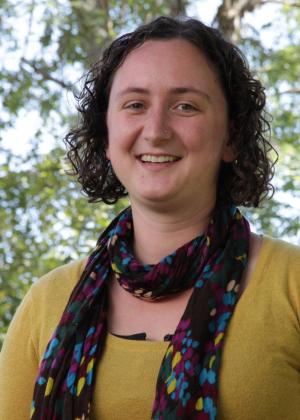 “From my experience as both student and teacher, I have found that the most memorable learning often occurs outside the classroom, when one applies knowledge to practice,” says Marlboro’s new sociology professor Katherine Rickenbacker. “Kat” is one of three new professors made welcome by Marlboro College this fall, in the areas of sociology, French and physics, each of them bringing fresh perspectives to the community.
“From my experience as both student and teacher, I have found that the most memorable learning often occurs outside the classroom, when one applies knowledge to practice,” says Marlboro’s new sociology professor Katherine Rickenbacker. “Kat” is one of three new professors made welcome by Marlboro College this fall, in the areas of sociology, French and physics, each of them bringing fresh perspectives to the community.
“I aim to send my students into the community when possible, to bridge the gap between theory and the ‘real world,’” explains Kat, who taught Introduction to Sociology and Inequality and “Natural” Disasters this fall. “I also believe that learning happens most effectively when students feel a sense of ownership of the course.”
Kat didn’t always know she would be a sociologist. “I fell into it,” she reminisces with a smile. “I went through five different majors as an undergrad before I had to declare. First I started with English, because I wanted to be a poet, which obviously has more job prospects than sociology. I finally settled on sociology, because it just made sense to me. Once I started graduate school, everything became so interesting.”
Kat received her bachelor’s degree in sociology, with a minor in environmental science and policy, from Smith College. She earned her master’s and doctorate in sociology from Northeastern University, with an emphasis in environmental sociology and the sociology of disaster and vulnerability. Her dissertation, “City Roots: Grassroots efforts to build social and environmental capital in urban areas,” examines small-scale urban greening projects in Dorchester, Massachusetts.
Kat is already applying her expertise in the area by joining Marlboro’s Environmental Quality Committee, which is responsible for facilitating environmental sustainability programs like recycling and composting on campus. She hopes to undertake some environmentally based projects with grassroots organizations in Brattleboro in the near future, continuing Marlboro’s service-learning pedagogy. As for teaching, Kat did not always know this was a strength.
“I almost left the program at Northeastern because one of the requirements was that you had to teach a class—just one,” Kat jokes. “I remember throwing up in the bathroom before my first class, because I was terrified of the 130 people sitting outside in that auditorium. But then I got hooked on it. Now it’s what I look forward to more than anything.” With a place as close-knit, yet independent, as Marlboro College, Kat is excited to discover alternative teaching methods to adjust for such a select group of students.
“Although I like the idea of small classes, I have never actually done this small,” marvels Kat, whose Introduction to Sociology class had only five students. “I think people here seem very interested in what they are doing and are really driven in whatever their individual projects are. Marlboro gives people who want to go to graduate school such an edge.”
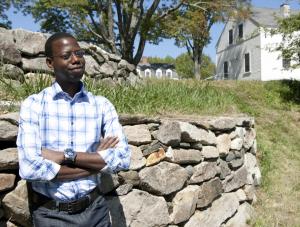 Marlboro’s new French professor, Boukary Sawadogo, has global experience, to put it mildly. Born in Abidjan, Cote d’Ivoire, “Abu,” has lived in Burkina Faso, where he grew up, as well as Ghana, Senegal, Iowa and Louisiana before finally ending up at Marlboro College.
Marlboro’s new French professor, Boukary Sawadogo, has global experience, to put it mildly. Born in Abidjan, Cote d’Ivoire, “Abu,” has lived in Burkina Faso, where he grew up, as well as Ghana, Senegal, Iowa and Louisiana before finally ending up at Marlboro College.
“Iowa, Louisiana, Vermont,” Sawadogo jokes. “It looks just like a circle. Where I came from in Africa, it was really hot. When I came to Iowa—very hot; Louisiana—still pretty hot. Now I’m here in Vermont. We do not even have a word for ‘snow’ in Burkina Faso, only ‘ice.’”
Abu received his bachelor’s degree in foreign languages, tourism and business from the University of Dakar, Senegal. He later went on to earn a graduate diploma in international relations from the Institute of Diplomacy & International Relations in Burkina Faso and a certificate for film production assistant from the University of Louisiana at Lafayette. He received his doctorate in Francophone studies from the University of Louisiana. His dissertation, “Altérité dérangeante et innovante dans le cinéma ouest-africain francophone de. 1990 à 2005,” examines the representation of marginal groups in francophone-African cinema.
“Precisely, I worked on the representation of the ‘mad man,’ the so-called ‘crazy person’ in film,” Abu explains. In addition, he has looked at the representation of homosexuals and women in African films. “I cannot say that women are ‘marginal groups’ because they represent 52 percent of the population in Africa. But I am interested in what happened in popular culture 200 or 300 years ago that put the traditional representation of women, once really powerful figures, on the margin.”
In addition to teaching French language and Francophone literature, and conducting a “French table” at the Twilight Tea Lounge in Brattleboro on Saturday afternoons, Abu looks forward to exploring issues of immigration and colonialism with his students—and of course African cinema. He delights in discovering, analyzing and interpreting depictions of change in filmography. Through the careful study of films that express the contravention of societal norms, Abu hopes to spark an interest in social progress in his students.
“Marlboro is small. But it’s not small in ideas,” Abu perceives. “I think that’s what matters. In terms of ideas and in terms of perspectives, Marlboro has nothing to envy of a larger university.” Abu remarked on the level of openness, care and concern for his well-being that has been expressed by Marlboro faculty since his first visit to the college. From colleagues helping to find him an apartment to others checking in on him when he missed soccer practice, he has felt very warmly welcomed.
“People were constantly checking up on me. I felt like others had my back here. Marlboro has flexibility, independence and a sense of community. It really speaks to me.”
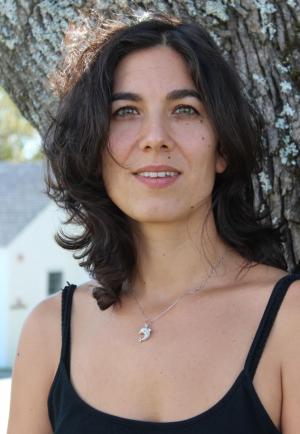 Sara Salimbeni, Marlboro’s new physics professor and a native of Rome, Italy, enjoys introducing students to some of the deepest mysteries of the universe. But she did not always know she would be an astronomer.
Sara Salimbeni, Marlboro’s new physics professor and a native of Rome, Italy, enjoys introducing students to some of the deepest mysteries of the universe. But she did not always know she would be an astronomer.
“When I was a child I wanted to be a painter,” Sara jests. “It didn’t work out.” Sara received her laurea in physics from the University of Rome, La Sapienza, and her doctorate in astronomy from the University of Rome, Tor Vergata. Her dissertation, “Cosmological evolution of galaxies from deep multicolor surveys,” examines how different galaxies have changed over billions of years.
“We have these wonderful pictures from the Hubble Space telescope, or telescopes in Chile and other parts of the world, from which we are able to understand many things that occur at different times,” Sara declares. “The light travels with a speed that is not infinite, so it takes time to get to earth. The farther away the galaxy you are watching, the more you are looking into the past.”
Sara is very much accustomed to an intimate academic setting and a relatively secluded place of study like Marlboro College. When she was working on her doctorate she did research at the Rome Observatory, located northwest of the city atop Monte Mario.
“It didn’t really feel like a university environment—it was fun,” Sara explains. “I was working with scientific researchers, not just professors. When I moved to the States in order to do postdoctorate work at UMass, I felt like I was missing something. I realized I needed to have an experience with students—I needed to teach.”
Sara spent a year teaching physics at the University of Massachusetts, Amherst, and then served as a visiting professor at Marlboro for a year, during which time she became a valued member of the community. Sara still thrives on her research, which she plans to continue, but now she wishes to find more overlap with the academic work of her students, to excite their interest. She hopes to find a balance between pursuing research and leading her day-to-day life with students in Marlboro’s tight-knit community.
“I was immediately impressed by the strong sense of community present at Marlboro,” says Sara. “I very much enjoy that the classes are small. I am able to work with each student in an individual way. When you have a big class, you tend to lecture. It’s very different to have four students in front of you, when you know they’ve read the material and you can discuss the most important things about the chapter. It’s a totally different kind of teaching.”
The Marlboro community welcomes these diverse faculty additions with excitement and regard, and looks forward to their many valuable and unique contributions to come.
Celebrating Jerry
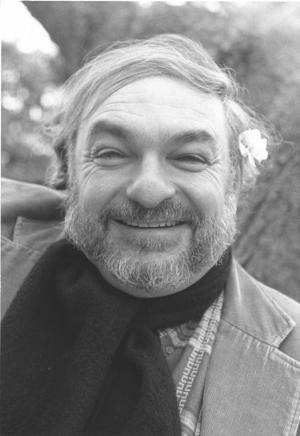 One of the highlights of the alumni reunion last May was a session organized by C.J. Churchill ’91 and Will Brooke-deBock ’87 to celebrate the career of Jerry Levy, Marlboro’s sociology professor since 1976. Potash Hill could not give Jerry a better retirement send-off than providing some choice excerpts from this session, in the words of his former students over the years.
One of the highlights of the alumni reunion last May was a session organized by C.J. Churchill ’91 and Will Brooke-deBock ’87 to celebrate the career of Jerry Levy, Marlboro’s sociology professor since 1976. Potash Hill could not give Jerry a better retirement send-off than providing some choice excerpts from this session, in the words of his former students over the years.
C.J. Churchill: I had no idea that I would be interested in sociology. I thought I was going to major in political science, but when I took Jerry’s Contemporary American Society course, I realized I found the thing I was looking for—and the teacher I was looking for. During my undergraduate years at Marlboro, Jerry taught me how to write and think like a sociologist and a humanist. I think he was bemused by my avid embrace of the Town Meeting political system, but as with so much else in life, he encouraged me to think of this activity ethnographically. In this endeavor as well as with the rest of life, Jerry taught me how to think like an outsider even while on the inside of a process. One of Jerry’s great gifts to his students was teaching them how to see the sorrows of the world with profound concern while also being able to understand the world with a sense of humor. We are all lucky to have had the pedagogical attention of this fine scholar and teacher. He has that rare commitment to the life of the mind and the care of the soul which striving, uncertain students attach themselves because they know through this they can realize the better parts of themselves that were otherwise hidden.
Will Brooke-deBock: Jerry has been at this college teaching sociology from Jimmy Carter to Barack Obama. And, I wanted to mention, everybody knows that Jerry has a very full, rich life as an actor, a politician, a musician, a chef and a writer. Jerry is good at a lot of things, and I have seen him do a lot of these things. I have eaten his meals, I have seen him act. Jerry is one of the greatest sociologists in this country, but what he is really a genius at is teaching students. I came to Marlboro College as a suburban kid who was very naive, who was an evangelical fundamentalist, and I teamed up with Jerry, kind of like Mutt and Jeff, the anarchist and the fundamentalist kid. Jerry was able to take somebody who was really unformed in a lot of ways and help me find the direction I wanted to go. So I really am indebted. And finally, I had the opportunity of sitting in Classical Sociological Thought again, 25 years after I took the course the first time, and I also got to sit in on a tutorial. Marlboro students are still exemplifying the experience we had. Jerry’s genius is in teaching, and Marlboro students, their genius is in learning.
Emilie Ring Read ’91: Jerry was my first adviser at Marlboro, and it was the most amazing experience for me, because he would look at my schedule and say “Look at all these different things you are studying. I wish I could do that.”
Sandi Huskey Oswalt ’91: I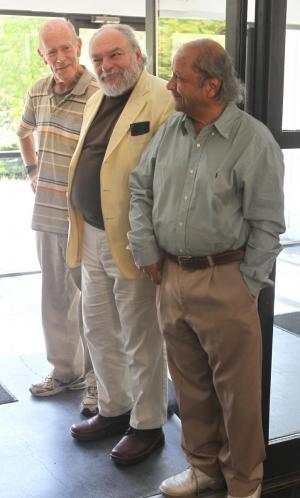 remember the first day of class at Marlboro— Jerry’s foreign policy. He warned us to be prepared, and I walked in the room and—this is so Marlboro—I sat down to a table of people and Jerry just sat back and said, “So….” And that was it, because we were expected to be prepared to discuss the material. That’s Marlboro: it wasn’t someone speaking at us, but someone teaching us to think.
remember the first day of class at Marlboro— Jerry’s foreign policy. He warned us to be prepared, and I walked in the room and—this is so Marlboro—I sat down to a table of people and Jerry just sat back and said, “So….” And that was it, because we were expected to be prepared to discuss the material. That’s Marlboro: it wasn’t someone speaking at us, but someone teaching us to think.
Heshan Berents-Weeramuni ’90: I entered Marlboro (from England) in 1987 and my mom said, “Listen, Reagan is president. This is a really, really conservative country you are going to. Be careful.” The very first person I met was Jerry. So much for that. One of the most generous things Jerry has shown me, intellectually, is his ability to look at society and show us how the magician’s hand moves slightly too slowly, and you can see how the trick is done, and that is a perspective that is indescribable.
Wendy Levy ’97: There were many questions that were sort of tumbling around in my head from high school and my upbringing—I was finally getting some answers to them from sociology. One of the comforting things was, I wasn’t the only one asking these questions: why are things so weird where I come from, why are things so weird everywhere, who’s controlling these things? And in Jerry’s classes those things started coming together. Every day I still use things I learned from Jerry’s class. I finally got to see Marx in Soho. What is it that Jerry can’t do?
Laura Hinerfeld ’93: When you are doing sociology and finding out how all these forces work you can go to these very dark places. But from Jerry there was always joy.
John Coakely ’02: What I love about Jerry as a teacher is that he lets you challenge yourself. I showed up here and wanted to study education, and I said, “So Jerry, do you want to do a tutorial on really interesting and alternative schools?” And he said “Okay, we can do it at five o’clock on Thursday afternoons, but I am going to get really tired.” I said, “Do you want me to get you some coffee for that?” He said, “No, I just may fall asleep.” And in that tutorial he made me read at least a book a week and told me to interview people doing interesting schools. It was great, and it was about the same amount of work I did in some of my graduate seminars.
Jaysinh Birjepatil, retired literature professor: Somebody said that everything Jerry does turns to gold. Whether it’s teaching, acting solo, or just being a human being. I remember we taught a class on the Holocaust together, and took the students to the Holocaust Museum in Washington, D.C., a place where there were just voices retelling their suffering. And Jerry sat down and started crying like a baby along with the students. He is somebody who is not an abstraction, although he can deal with very abstract topics. He brings a kind of honest nature that responds to stimulus without being ashamed of being a teacher weeping at a museum. He is really the most genuine person I have met in my life.
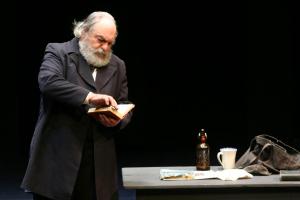 Jerry: I am just amazed at how many of you have turned out and how I remember every one of you, and what you did on your Plan. So many of you did such remarkable work that I wish you could just go to the library and read some of these Plans. And I am so gratified that I have had such influence on you, and I just want to say this: to an extent, if I was such a good teacher, it was because you came here with a seriousness and a sense of purpose that is profound. Each one of you—I am looking; I don’t see any exceptions—each one of you was so serious about your work, whether you were ready to do the work or not, whether you could write or not, you wanted something special.
Jerry: I am just amazed at how many of you have turned out and how I remember every one of you, and what you did on your Plan. So many of you did such remarkable work that I wish you could just go to the library and read some of these Plans. And I am so gratified that I have had such influence on you, and I just want to say this: to an extent, if I was such a good teacher, it was because you came here with a seriousness and a sense of purpose that is profound. Each one of you—I am looking; I don’t see any exceptions—each one of you was so serious about your work, whether you were ready to do the work or not, whether you could write or not, you wanted something special.
Listen to a full recording of comments at Jerry’s reception.
Also retiring this year is Paul Nelsen, theater professor for 35 years. Potash Hill will give Paul a fond farewell in the Summer 2013 issue.
Galbraiths leave library legacy
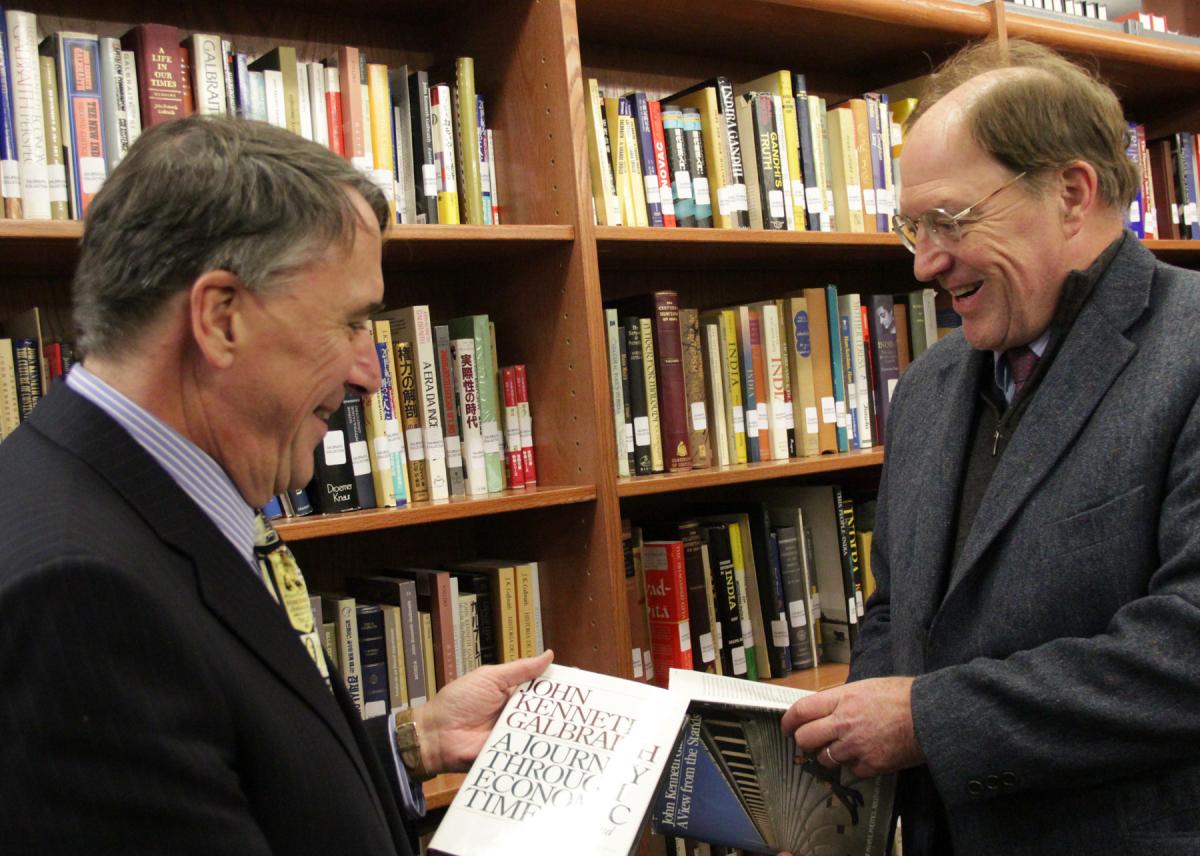 In November, Marlboro dedicated the John Kenneth and Catherine Atwater Galbraith Library Collection, a gift from their sons Peter, James and Alan in recognition of their parents’ relationship with Marlboro as trustee, friend and neighbor. James Galbraith and Peter Galbraith, a current Marlboro trustee, each offered their views on the legacy of their father in a symposium following the dedication.
In November, Marlboro dedicated the John Kenneth and Catherine Atwater Galbraith Library Collection, a gift from their sons Peter, James and Alan in recognition of their parents’ relationship with Marlboro as trustee, friend and neighbor. James Galbraith and Peter Galbraith, a current Marlboro trustee, each offered their views on the legacy of their father in a symposium following the dedication.
“A library is a window into the lives of the people that built it,” said Emily Alling, library director, in her dedication comments. “Looking through the books that now sit on these shelves, one certainly finds that the academic interests and career paths of both Galbraiths are robustly represented. But alongside biographies of prominent politicians, we find a worn copy of Dr. Spock’s Baby and Child Care. Books on Vermont are nestled in among books on India and China. Edward Gorey’s Amphigorey is interfiled with classic works of literature.”
Emily added, “In the months since the collection has been installed and shelved, many people have expressed surprise and delight at being able to view and even handle books belonging to one of the 20th century’s most prominent public intellectuals. The collection is located such that every admissions tour on campus pauses next to it as they wait to enter the Plan Room, where Marlboro graduates’ Plans of Concentration are shelved. It is fitting that prospective students and their families are welcomed to Marlboro by a collection of books that reflects so many of our institutional interests—a global perspective, economics and sustainability, the study of languages and literature—as well as the college’s historical and ongoing connections with the Galbraith family.
And More
Anthropology professor Carol Hendrickson hosted a four-week visit this fall from her friend and colleague Ana Gloria Ajzac Tetzagüic, who works with women’s groups in Guatemala on a range of projects, from microfinancing to gender rights. Gloria spoke with Carol’s Food and Culture class, participated in the World Studies Colloquium, interacted with Spanish language students and enjoyed being part of campus life. Photo by Dianna Noyes
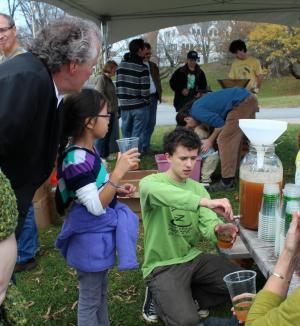 Students press fresh cider with the help of family members at Family Day in October. Other highlights were academic sessions, from “kitchen-chemistry” to dance choreography, as well as hiking, clambering up the climbing wall and dancing to live music from The Horse Flies. Photo by Elisabeth Joffe
Students press fresh cider with the help of family members at Family Day in October. Other highlights were academic sessions, from “kitchen-chemistry” to dance choreography, as well as hiking, clambering up the climbing wall and dancing to live music from The Horse Flies. Photo by Elisabeth Joffe
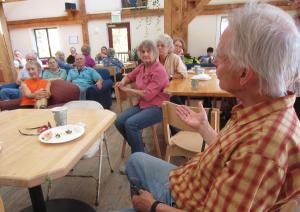 Retired biology professor Bob Engel holds forth on the intricacies of ornithology at the October “seniors’ lunch.” The monthly event invites area elders to enjoy the sunny campus center, a scrumptious lunch provided by the dining hall crew, and each other’s company. Photo by Dianna Noyes
Retired biology professor Bob Engel holds forth on the intricacies of ornithology at the October “seniors’ lunch.” The monthly event invites area elders to enjoy the sunny campus center, a scrumptious lunch provided by the dining hall crew, and each other’s company. Photo by Dianna Noyes
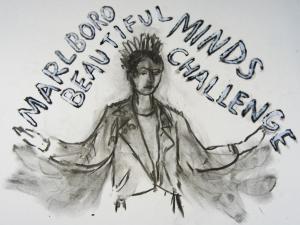 Beautiful Minds come to Marlboro: “One of Marlboro’s greatest strengths is the opportunity for students and faculty to work across disciplines and engage with meaty questions that have real-world implications,” says Ariel Brooks, director of non-degree programs at Marlboro. This was the idea behind the Beautiful Minds Challenge, a contest to attract innovative high school students from across the country. Teens were invited to create an original expression of beauty that pulled from multiple perspectives or took an innovative approach, in response to the prompt, “Make something beautiful. Say why it is.” Submissions were due in December, and 20 contestants will win a trip, expenses paid, to a student symposium at Marlboro College in February. Illustration by Raf Kelman ’09
Beautiful Minds come to Marlboro: “One of Marlboro’s greatest strengths is the opportunity for students and faculty to work across disciplines and engage with meaty questions that have real-world implications,” says Ariel Brooks, director of non-degree programs at Marlboro. This was the idea behind the Beautiful Minds Challenge, a contest to attract innovative high school students from across the country. Teens were invited to create an original expression of beauty that pulled from multiple perspectives or took an innovative approach, in response to the prompt, “Make something beautiful. Say why it is.” Submissions were due in December, and 20 contestants will win a trip, expenses paid, to a student symposium at Marlboro College in February. Illustration by Raf Kelman ’09
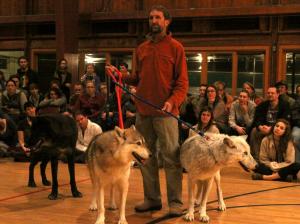 In October, Kent Webber, director of the Colorado-based Mission:Wolf sanctuary, shared three of his captive-raised ambassador wolves with an entranced crowd in Persons Auditorium. The event was hosted by Adam Katrick ’07 and biology professor Jaime Tanner. Photo by Patrick Lancaster
In October, Kent Webber, director of the Colorado-based Mission:Wolf sanctuary, shared three of his captive-raised ambassador wolves with an entranced crowd in Persons Auditorium. The event was hosted by Adam Katrick ’07 and biology professor Jaime Tanner. Photo by Patrick Lancaster
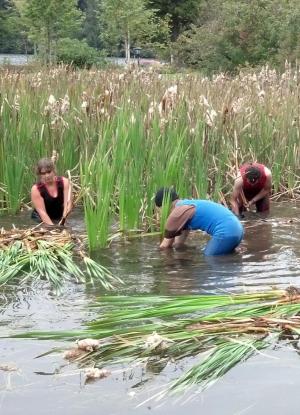 Students gather cattails for weaving and cordage as part of a forest skills workshop, a recurring event on and around campus led by juniors Mason Jones and Ariel Victor Qadesh. New students from the Bridges orientation trip titled Apocalypse Soon are frequently joined by others as they build shelters, look for edible and medicinal wild plants and learn survival skills.
Students gather cattails for weaving and cordage as part of a forest skills workshop, a recurring event on and around campus led by juniors Mason Jones and Ariel Victor Qadesh. New students from the Bridges orientation trip titled Apocalypse Soon are frequently joined by others as they build shelters, look for edible and medicinal wild plants and learn survival skills.
Worthy of note
Last summer, ceramics professor Martina Lantin and art history professor Felicity Ratté (right) spent two weeks in Turkey, conducting research for a trip with their spring 2013 class, Art on the Walls: Ceramic Tiles in Seljuk and Ottoman Architecture, Meaning and Design. “The course is designed to give students a hands-on, practitioner’s introduction to the design, style and history of Islamic architectural tile,” said Felicity. Their travels took them from a contemporary tile-manufacturing workshop in Kutahya to Bursa, the Ottoman Empire’s first capital, to Iznik, renowned for its ceramic work in the 16th century. “We left Turkey with a course mapped out and the itinerary planned for students. We are excited by the many questions fresh in our minds and the vast array of inspiration in our heads.”
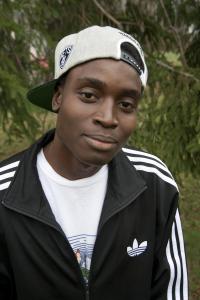 “Music and dance are a big part of culture in Medellin, which was like another Queens for me,” said senior Kalie Kamara (left), who spent eight weeks in a Spanish language intensive in Columbia. He stayed with an older couple but met many young people in neighborhood parks and was pleased to find that hip hop music was also very popular there. Kalie took language classes every morning, and spent his evenings doing homework and writing rhymes in Spanish to rap with his new friends. “My style was definitely fresh for them to hear, and they knew I was trying. I tried every day. Every moment those kids asked me, and I had enough feeling for it, I freestyled my verses en Español.”
“Music and dance are a big part of culture in Medellin, which was like another Queens for me,” said senior Kalie Kamara (left), who spent eight weeks in a Spanish language intensive in Columbia. He stayed with an older couple but met many young people in neighborhood parks and was pleased to find that hip hop music was also very popular there. Kalie took language classes every morning, and spent his evenings doing homework and writing rhymes in Spanish to rap with his new friends. “My style was definitely fresh for them to hear, and they knew I was trying. I tried every day. Every moment those kids asked me, and I had enough feeling for it, I freestyled my verses en Español.”
“In Emplumada, Chicana poet Lorna Dee Cervantes uses natural imagery to chart a kind of ecological map that records the roots, and routes, that conform to her hybrid identity,” said Spanish professor Rosario deSwanson. In November, Rosario presented a paper on Cervantes and chaired a panel at the New England Council of Latin American Studies (NECLAS) meeting on New Perspectives on Latino Literature and Education, held at Yale University. She also published an article in Hispania, on a feminist Mexican adaptation of Oscar Wilde’s Salome, and a paper on Uruguayan and Argentinian writers in Hispanic Journal.
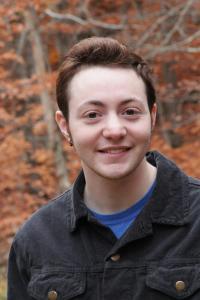 “I’m a literature person, but this is well off the path of what I’ve ever worked on at Marlboro,” said Marlboro junior Adam Halwitz (right), referring to his short story “Power Out.” The piece was featured in a new volume of literary fiction by transgender authors called The Collection, published in October by Topside Press. The Collection features many leading North American authors in this genre, so Adam is understandably proud. “When I saw what the book actually looked like—and there were several stages, each of which got more and more nerve-racking and wonderful—I was even more honored to have been included.”
“I’m a literature person, but this is well off the path of what I’ve ever worked on at Marlboro,” said Marlboro junior Adam Halwitz (right), referring to his short story “Power Out.” The piece was featured in a new volume of literary fiction by transgender authors called The Collection, published in October by Topside Press. The Collection features many leading North American authors in this genre, so Adam is understandably proud. “When I saw what the book actually looked like—and there were several stages, each of which got more and more nerve-racking and wonderful—I was even more honored to have been included.”
“Vermont is known for a lively and varied artistic life,” wrote Ellen McCulloch-Lovell, Marlboro president. “We boast that we are home to more artists per capita than any other state.” Ellen’s essay on the history of the arts in Vermont, “Vermont’s Creative Spirit: Arts and Arts Organizations,” appears in a new book, The Vermont Difference, to be published in 2013. She was also a featured speaker at the Landmark College academic speaker series titled “Turning Points: Making Choices in Politics, Science and Health,” in November. Ellen offered a behind-the-scenes look at the presidential elections based on her years in the Clinton Administration and as chief of staff to U.S. Senator Patrick Leahy.
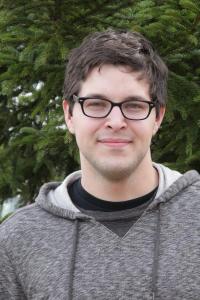 Last summer, sophomore Michael Sirois (left) spent six weeks at Freie Universität Berlin (FUBiS), improving German speaking and writing skills. “While I would still describe myself as far from fluent, I can now converse easily (if somewhat slowly) in German in most situations,” said Michael. He found that one of the most useful outcomes was establishing German-speaking friends and contacts. “So far, I’ve given my curry recipe in German to a FUBiS friend in Norway, I’m in the middle of a lengthy Facebook conversation in German about the history of rap with another friend from North Carolina, and I Skype weekly in German with yet another friend who lives in Frankfurt. All of this means that I’m learning German organically and independently outside of a classroom.”
Last summer, sophomore Michael Sirois (left) spent six weeks at Freie Universität Berlin (FUBiS), improving German speaking and writing skills. “While I would still describe myself as far from fluent, I can now converse easily (if somewhat slowly) in German in most situations,” said Michael. He found that one of the most useful outcomes was establishing German-speaking friends and contacts. “So far, I’ve given my curry recipe in German to a FUBiS friend in Norway, I’m in the middle of a lengthy Facebook conversation in German about the history of rap with another friend from North Carolina, and I Skype weekly in German with yet another friend who lives in Frankfurt. All of this means that I’m learning German organically and independently outside of a classroom.”
“My mailbox is the source for about 18 percent of the school’s recycling haul, from the flyers for the erotic hypnotist to the pamphlets for the indie-band-with-an-environmental-message, to (my favorite of all time) a letter asking me to shell out hundreds of dollars to buy the rights to a four-line poem that, if placed correctly on magnets, mugs, and bumper stickers, will most assuredly create a sense of campus community.” So writes Ken Schneck, Marlboro’s dean of students and author of a Huffington Post blog on college life. From the impact of social networking to the pitfalls of discrimination, Ken finds something witty to say about every aspect of life on campus.
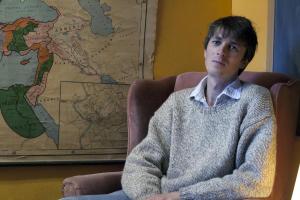 “The best thing about doing a teaching fellowship at Marlboro is teaching bright and engaging students,” said Evelyn Richardson (right), Marlboro’s 32nd classics fellow from Oxford, who was welcomed to the community in August. “I’ve been impressed by the confidence students here have to think originally.” Evelyn received his bachelor’s in classics and Arabic from Oxford, and received the Chancellor’s Latin Verse Prize and the Richard Hillary Creative Writing Prize in 2011. He is interested in studying the interaction between Greek and Roman culture, especially from the Roman perspective. “It’s a complicated and often contradictory story that can be traced on many levels—not just in poetry and visual art but also in really fine details of social behavior.”
“The best thing about doing a teaching fellowship at Marlboro is teaching bright and engaging students,” said Evelyn Richardson (right), Marlboro’s 32nd classics fellow from Oxford, who was welcomed to the community in August. “I’ve been impressed by the confidence students here have to think originally.” Evelyn received his bachelor’s in classics and Arabic from Oxford, and received the Chancellor’s Latin Verse Prize and the Richard Hillary Creative Writing Prize in 2011. He is interested in studying the interaction between Greek and Roman culture, especially from the Roman perspective. “It’s a complicated and often contradictory story that can be traced on many levels—not just in poetry and visual art but also in really fine details of social behavior.”
“The Plan isn’t just an academic accomplishment,” said one student quoted in Colleges That Changes Lives: 40 schools That Will Change the Way You Think About Colleges. “It’s an opportunity to explore something I care about. No matter what you’re doing, it’s driven by passion.” Marlboro College was pleased to be featured once again in the fourth edition of CTCL, the perennially popular guide to profound learning experiences, as it has since the first edition in 1995. According to the new edition, “Marlboro is a transformative place that turns out the essential leaven of democracy: bold, clear thinkers; people of vision and character. Quite simply, the college fulfills the promise of liberal education.”
For more information on:
Felicity Ratté and Martina Lantin
Adam Halwitz
Ken Schneck
Marlboro College
Or for the most up-to-date scoop:
Potash Phil
Facebook
Youtube
Twitter